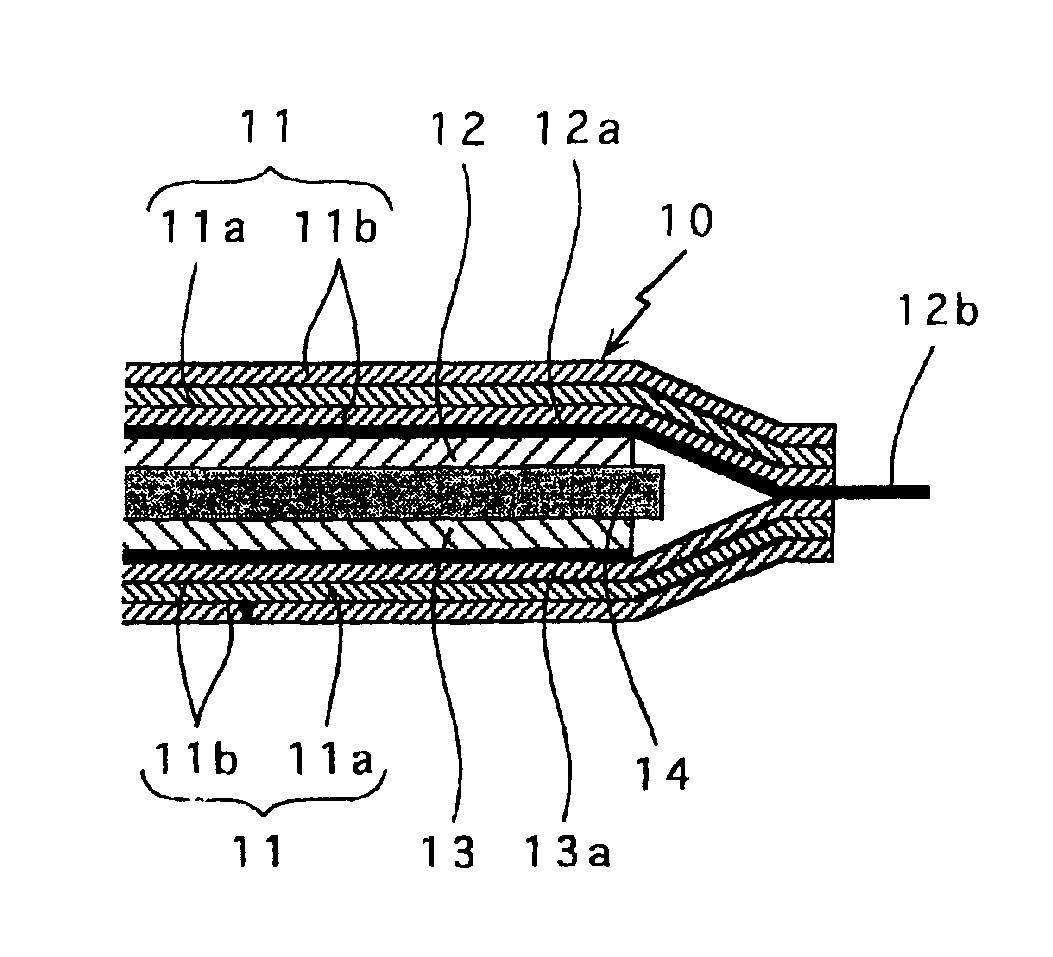Negative electrode for lithium secondary battery and lithium secondary battery
a secondary battery and negative electrode technology, applied in the direction of negative electrodes, cell components, electrochemical generators, etc., can solve the problems of increasing thickness of lithium secondary batteries such as card types, and the sintering process cannot achieve a significant increase in adhesion between the negative electrode collectors, so as to achieve high energy density, increase adhesion, and great capacity density
- Summary
- Abstract
- Description
- Claims
- Application Information
AI Technical Summary
Benefits of technology
Problems solved by technology
Method used
Image
Examples
example a1
[0053]In Example A1, the following procedures were taken to prepare a negative electrode, positive electrode and non-aqueous electrolyte for fabrication of a thin lithium secondary battery as shown in FIGS. 1 and 2A-2B.
(Fabrication of Negative Electrode)
[0054]A negative electrode was fabricated as follows. A copper foil having a thickness of 35 μm, a proportional limit of 2.06 N / mm and an arithmetic mean surface roughness Ra of 1.0 μm was used as a negative electrode collector.
[0055]A silicon powder to be alloyed with lithium was used as a negative electrode material. A slurry was prepared by blending the silicon powder with polyvinylidene fluoride, as a binder resin, in a weight ratio of 9:1, and admixing the resultant mixture with N-methyl-2-pyrrolidone. The slurry was applied to one side of the negative electrode collector of copper foil using the doctor blade technique. The slurry was dried and then heat treated at 400° C. for 30 hours in a vacuum atmosphere. Subsequently, the c...
example b1
[0068]In Example B1, the following procedures were taken to prepare a negative electrode, positive electrode and non-aqueous electrolyte for fabrication of a flat coin-type lithium secondary battery as shown in FIG. 4.
(Fabrication of Negative Electrode)
[0069]A negative electrode was fabricated as follows. A copper foil having a thickness of 35 μm and an arithmetic mean surface roughness Ra of 0.5 μm was used as the negative electrode collector.
[0070]A negative electrode composite slurry was prepared as follows. A silicon powder having a mean particle size of 3 μm was used as a negative electrode material, whereas Ketchen black having a mean particle size of 0.3 μm was used as a conductive carbon material. Polyamic acid was employed for forming polyimide as a binder resin. The silicon powder, Ketchen black and polyamic acid were weighed out in a weight ratio of 8.6:1.57:19.8. The silicon powder and Ketchen black were blended with a polyamic acid solution in N-methyl-2-pyrrolidone to ...
example b2
[0077]In Example B2, a negative electrode was fabricated the same way as in Example B1, except that a copper foil having a thickness of 35 μm and an arithmetic mean surface roughness Ra of 0.2 μm was used as the negative electrode collector. In this negative electrode, a ratio of the thickness X of the negative electrode composite layer versus the arithmetic mean surface roughness Ra of the negative electrode collector (=X / Ra) was at 75.
[0078]A lithium secondary battery of Example B2 was fabricated the same way as in Example B1, except that the negative electrode thus fabricated was used.
PUM
| Property | Measurement | Unit |
|---|---|---|
| arithmetic mean roughness | aaaaa | aaaaa |
| mean particle size | aaaaa | aaaaa |
| mean particle size | aaaaa | aaaaa |
Abstract
Description
Claims
Application Information
 Login to View More
Login to View More - R&D
- Intellectual Property
- Life Sciences
- Materials
- Tech Scout
- Unparalleled Data Quality
- Higher Quality Content
- 60% Fewer Hallucinations
Browse by: Latest US Patents, China's latest patents, Technical Efficacy Thesaurus, Application Domain, Technology Topic, Popular Technical Reports.
© 2025 PatSnap. All rights reserved.Legal|Privacy policy|Modern Slavery Act Transparency Statement|Sitemap|About US| Contact US: help@patsnap.com



